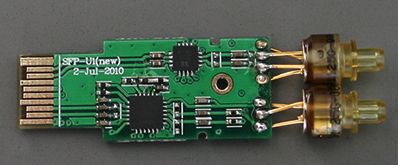What is inside SFP Modules – Understanding TOSA, ROSA, BOSA
We all know the importance of SFP transceivers. In fact, different types of SFPs and their advantages have been discussed in many articles. But it is also important to understand what is inside SFP Modules, how the functions of transmitting, receiving and signal conversions(electric signal to light and light to an electric signal) are happening. Haven’t you ever wondered about this? Such a small device performing all these actions with many of its advantages. This article will give you the best idea for this answer by covering TOSA, ROSA and BOSA.
Fiber optic transceivers are key components of the fiber optic transmission network. They are designed in small form-factor with some integrated optical sub-assemblies which can be suitable for the high-density network. There are many SFPs available in the market with different features and specifications(SFP & SFP+). Aren’t you aware of the major functions of these transceiver modules?
- SFPs will transmit data and receive the data.
- Transceivers provide the conversion of the electrical signals to optical signals and vice versa.
Considering the size and structure of an SFP transceiver, have you ever wondered how these functions are achieved? Transceivers are the important component of any network. Inside the metal casing of a transceiver, there are several components and sub-assemblies that join together to form this. The most important components inside of transceivers are:
- Transmitter Optical Sub Assembly (TOSA)
- Receiver Optical Sub Assembly (ROSA)
- Bi-Directional Optical Sub Assembly (BOSA)
This division is based on the function that will be performed on SFPs.

We all know that in a normal SFP module there are two ports which are Transmit(TX) and Receive(RX). The components of TOSA are for the transmitting side and components of ROSA is for the receive function.
Transmitter Optical Sub Assembly (TOSA)
TOSA is the component inside the transmit side of SFP ports which is responsible for converting the electrical signal into an optical signal and then transmitting it over the optical fiber strand connected to it. The transmitter optical sub-assembly consists of a laser diode, optical interface, monitor photodiode, metal and/or plastic housing, and electrical interface. The TOSA is an essential component of every fiber optic transceiver. Depending upon the required functionality and application, other components may be present as well including filter elements and isolators.

Receiver Optical Sub Assembly (ROSA)
ROSA is the component inside the receiver side of the SFP port. The ROSA is responsible for receiving the optical signal transmitted by the TOSA of the opposite end’s transceiver and converting it back to an electrical signal so that the communication equipment can understand it. The Receiver optical sub-assembly consists of a photodiode, a housing and the electrical interface. The Photodiode receives the optical signal, the housing provides the metal or plastic cover and the electrical interface connects to the communication equipment. The ROSA is also an essential component of every fiber optic transceiver. A pair of TOSA and ROSA combined together forms the optical transceiver. The ROSA may also contain an amplifier to enhance the received signal.

Bi-Directional Optical Sub Assembly (BOSA)
TOSA and ROSA are essential components in the uni-directional transceivers (traditional transceivers) which transmit on one fiber optic strand and receive on the other fiber optic strand. But we have also discussed the BiDi SFPs are available in the market with great advantage. In the case of bi-directional transceivers, BOSA is used which is a combination of a TOSA, a ROSA and additionally a WDM filter. The WDM filter enables the bi-directional transceiver to split the wavelengths into two separate wavelengths. After the wavelengths are split, transmit and receive functions can work on a single strand of fiber.

Summary
Physical structure of SFP modules is pretty simple and manageable. The data transmission unit will transmit and the receiver side will receive data that is supported by two different components which are mainly categorized as TOSA and ROSA. We have the BiDi SFP’s also which combined the function of transmitting and receive together. Hence the function of transceiver and receive is achieved using the method BOSA.
Have a comment or points to be reviewed? Let us grow together. Feel free to comment.


We like to integrate a TOSA and ROSA module on our own board (becaus of mecanical space). Is it possible to order the TOSA, ROSA or BOSA module as OEM?